Planting tall evergreen trees is an attractive and organic way to landscape your yard, whether you seek to achieve peaceful woodland seclusion or simply create privacy for your home. Evergreen trees can provide a green, dense, year-round natural barrier. Because certain species grow very quickly, planting a row of young evergreen trees can yield as much as 5 feet of growth each year. At that rate, you will achieve a natural shield of tall, beautiful evergreen trees in just a few years.
Two of the most popular evergreen trees planted by home landscapers are the Leyland cypress and the Thuja ‘Green Giant’. In fact, these often get compared because they do have a lot in common.
Here are some commonalities between the two:
- Both are coniferous, evergreen trees in the Cupressaceae family
- Both tolerate a range of soil conditions and can thrive in full sun
- Both are hybrid cultivars developed in the 20th century
- Both grow well in USDA Hardiness Zones 6-8
However, there are also several differences between the Leyland cypress or Thuja ‘Green Giant’ to keep in mind when deciding whether to plant one or the other. This article will compare and contrast the two trees so that by the end, you understand the history and origins of both, their differences in appearance, and their growing needs. Let’s dive into learning more about these two trees now!
Comparing Leyland Cypress and Thuja Green Giant
| Characteristic | Leyland Cypress | Thuja ‘Green Giant’ |
|---|---|---|
| Scientific Name | Cuprocyparis leylandii | Thuja ‘Green Giant’ (Previously known as Thuja standishii x plicata ‘Green Giant’) |
| Family | Cupressaceae | Lamiaceae |
| Common Name | Leyland cypress | green giant arborvitae, Thuja ‘Green Giant’, green giants |
| Origin | Hybrid cultivar with parents species from North America | Hybrid cultivar with parents from North America and Japan, originally developed in Denmark |
| Description of Plant | Leyland cypress is a coniferous evergreen tree. It grows to be between 60 and 70 feet tall and 10 to 15 feet across. | Green giant arborvitae is a coniferous evergreen tree. It typically grows to be between 20 and 40 feet tall and 12 to 18 feet across. |
| Growing Conditions | Leyland cypress grows well in full sun to partial shade in moist, well-drained soil. It tolerates a range of soils and can grow in soil that is acidic to slightly alkaline. | Green giant arborvitae grows well in full sun with light afternoon shade. It tolerates a range of soils. |
| USDA Hardiness Zone(s) | 6-10 | 5-8 |
Descriptions of Leyland Cypress and Thuja Green Giant
Both the Leyland cypress and the Thuja ‘Green Giant’ are coniferous, evergreen trees. This means that they both have needles, rather than leaves. These needles stay green all year long. Most trees fall into one of two categories. The first category is deciduous trees, which produce leaves that change colors and fall to the ground as cooler temperatures set in during the autumn season. In contrast, the second category is coniferous trees, which bear cones to disperse their seeds. They also produce needles, which do not fall off for the majority of species. There are several species that don’t fit neatly into either category. This third group is known as deciduous conifers, and they both bear cones and form needles, which then fall in the autumn season.
Both the Leyland cypress and Thuja ‘Green Giant’ fit into the second category described above. They are coniferous trees and part of a group of more than 600 different coniferous species. These grow around the world and various species are native to a range of environmental conditions and climates. Some of the most readily recognizable North American conifers are pine, spruce, fir, and cedar trees. However, Leyland cypress and Thuja ‘Green Giant’ trees are also commonly planted conifers that you will find across North America. Let’s learn more about each of them now.
Description of Leyland Cypress
Cuprocyparis leylandii, or Leyland cypress, is a coniferous, evergreen, fast-growing tree. This species is a hybrid of two other plants: the Monterey cypress (Cupressus macrocarpa) and the nootka false cypress (Chamaecyparis nootkatensis). The Leyland cypress is a member of the Cuprocyparis genus and the Cupressaceae family. Cupressaceae includes approximately 30 genera which encompass more than 130 different species. The Leyland cypress has relatives in the Cupressaceae family which include junipers and redwoods, including the famous sequoia trees of Northern California.
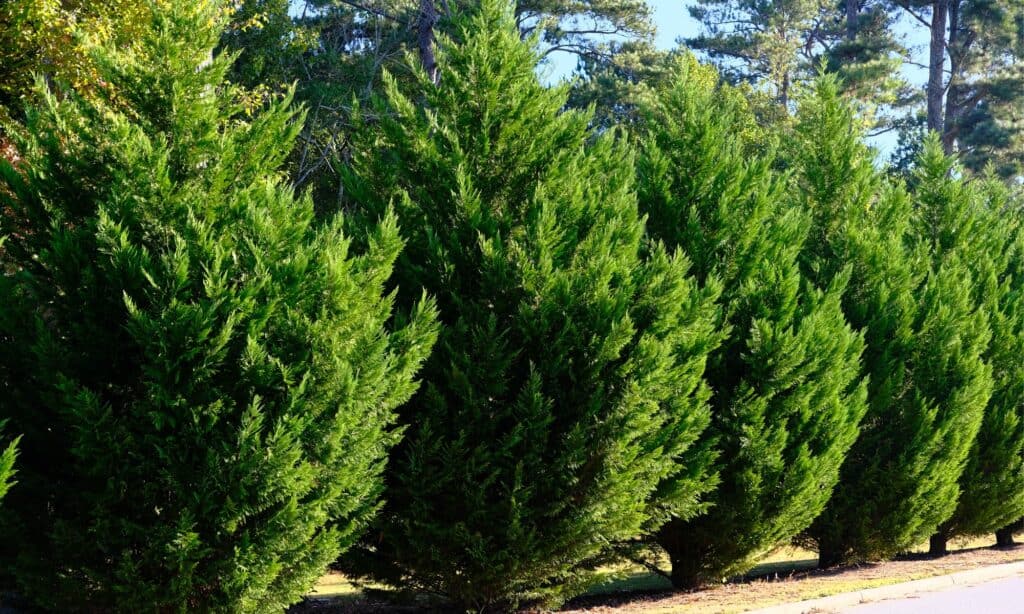
Leyland cypress is a coniferous evergreen tree that grows 60 and 70 feet tall and 10 to 15 feet across.
©iStock.com/dbvirago
Description of Thuja ‘Green Giant’
Thuja ‘Green Giant’, also known as simply ‘Green Giant’, green giant arborvitae, or green giants, is also a coniferous, evergreen, fast-growing tree. Like the Leyland cypress, the green giant is also a hybrid of two other plants: the western redcedar (Thuja plicataI) and the Japanese arborvitae (Thuja standishii). The ‘Green Giant’ is a member of the Thuja genus, which is in the Cupressaceae family. Thuja includes six species of coniferous evergreen trees, which include both dwarf cultivars and much larger varieties.
The ‘Green Giant’ is considered to have a rapid growth rate, growing to 30 feet tall by the age of 30. At full maturity, green giants can grow to be 60 feet tall with a 12-to-20-foot spread, growing dense, dark green foliage in a tight pyramid shape. Because it is adaptable to a range of soils, is not susceptible to many pests or diseases, and does not require much (if any) pruning, green giants are recommended for planting on their own or to be grown in a row as a hedge. They are also recommended as an alternative to Leyland cypress trees.
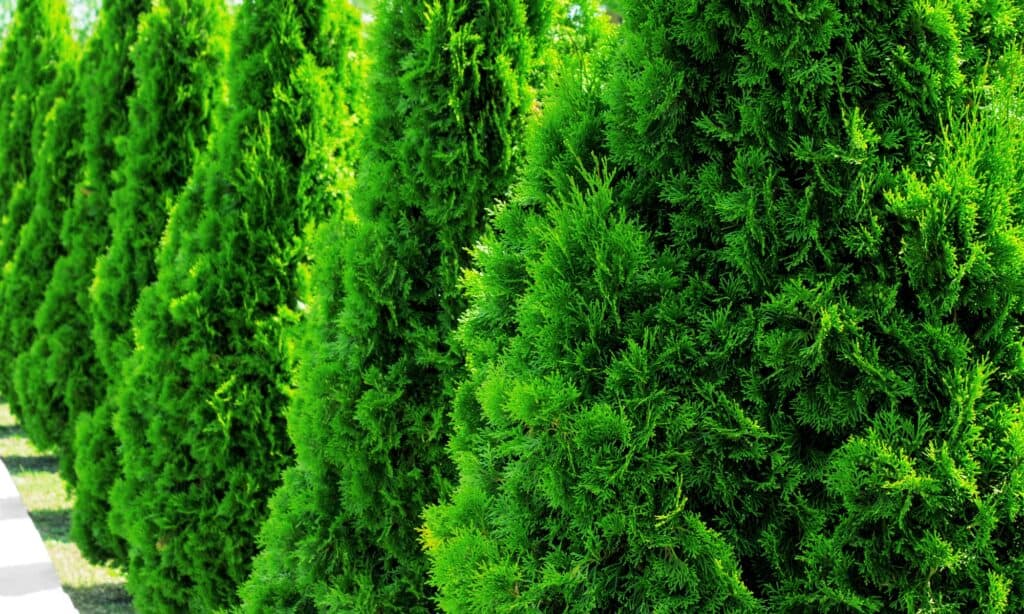
Green giants typically grow 20 – 40 feet tall with a 12-to-20-foot spread and dense, dark green foliage shaped in a tight pyramid.
©iStock.com/Mykola Sosiukin
Key Differences
Now that we’ve covered the basics, let’s explore some more of the differences between the Leyland cypress and Thuja ‘Green Giant’. We will cover their histories, differences in appearance, growing conditions, and uses in modern life.
Leyland Cypress vs. Thuja ‘Green Giant’: History
History of Leyland Cypress
The Leyland cypress is considered a natural hybrid cultivar. It is considered “natural” because the variety developed when a man named C. J. Leyland planted the seeds from an Alaska (Nootka) cedar (Callitropsis nootkatensis) cone, which had been fertilized by the Monterey cypress (Cupressus macrocarpa). The result proved to be attractive and had incredible growth rates. It was named after C. J. Leyland and became widely popular after being cultivated in the 1800s. One of their main uses was for creating privacy screens and hedges. The cultivar is still used for that purpose today. However, Leyland cypresses grow tall but have shallow roots. Because of this, they can be dangerous in the face of strong winds. Over time, the classification of Leyland cypress has changed. In fact, the genus it belongs to is still debated.
History of Green Giants
In 1967, green giants were introduced by way of an individual plant specimen to the U.S. National Arboretum. The plant arrived from Denmark, where it had been discovered in the 1930s.
However, for several years, scientists were confused about the true identity of green giants. It wasn’t until the 1990s that scientists used DNA analysis and research to identify the plant as a hybrid of the Japanese arborvitae, Thuja standishii, and the western redcedar, Thuja plicata. Because of this, it gained the name Thuja standishii x plicata ‘Green Giant’. When a major U.S.-based nursery business began propagating young plants, it soon became a bestseller.
The tree began gaining popularity in part because it is easy to care for, fast-growing, and seems to be resistant to pests and disease. As a result, the public bought millions of plants to replace old garden hedges and diseased trees that had been planted in the earlier part of the 20th century and were decaying and in need of replacement. Today, it is considered one of the most popular hedge plants in the United States.
Leyland Cypress vs. Thuja ‘Green Giant’: Appearance
You can look for Leyland cypress trees to have grayish-green sprays of foliage, with a slightly textured appearance. The trees also have reddish-brown bark. At maturity, Leyland cypress trees can grow to be as tall as 60 or 70 feet tall. They have a rapid growth rate, typically adding 2 to 4 feet of new growth each year during the tree’s youth. Leyland cypress trees also bear small green cones that are as small as .75 inches or as large as 9 inches long.
Thuja ‘Green Giant’ has vibrant green, scale-like foliage, which has a textured appearance. Compared to the Leyland cypress, the green giants appear to be very dense and bright green. This is in contrast to the grayish-green, less dense foliage of the Leyland cypress. They grow in sprays and their needles become darker over the course of the winter. At maturity, green giants are smaller than the Leyland cypress, typically growing to be 20 to 40 feet tall and forming a cone, or triangle, shape. The tallest ones may reach 60 feet, though they are usually shorter. However, their rapid growth rate of 3 to 5 feet each year during their youth make them a favorite option for growing a hedge quickly. Thuja green giants also bear small green cones, which are about .5 inch long and turn brown when mature.
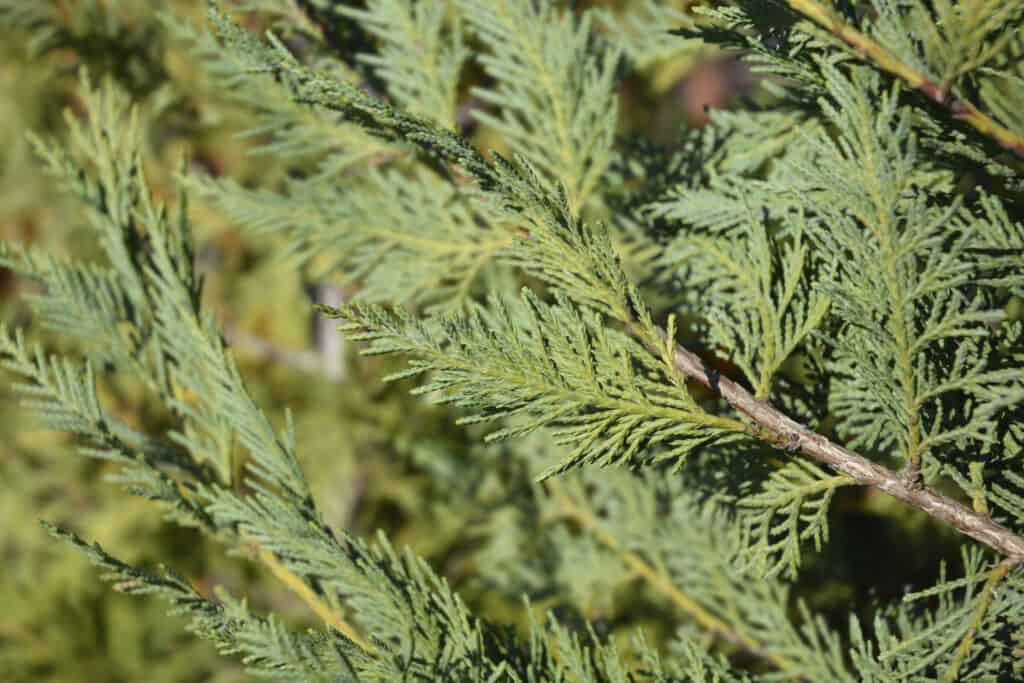
Leyland cypress trees have grayish-green sprays of foliage, with a slightly textured appearance.
©iStock.com/Nahhan
Leyland Cypress vs. Thuja ‘Green Giant’: Growing Conditions
It is important to remember that Leyland cypress trees grow well in full sun and somewhat moist soil with good drainage. However, without adequate soil drainage, Leyland cypress trees are susceptible to root rot. This can cause the trees to die. Aside from that, Leyland cypress trees will tolerate clay, loam, or sandy soils and can grow in acidic or alkaline soils. However, Leyland cypress trees do need regular pruning, otherwise their growth will get out of hand quickly. They grow well in USDA Hardiness Zones 6 – 10 and cannot tolerate temperatures that dip significantly below 0 degrees Fahrenheit. However, they are tolerant of drought and can handle hot and dry climates. Dry soil will be better for the Leyland cypress than waterlogged soil, which would damage the root system.
Green giants also grow in full sun but will thrive best when they have access to afternoon shade. They also thrive in moist soil that has good drainage. While it tolerates a range of soil conditions, it will not thrive in salty soil. One of the benefits of growing green giants is that they are a species resistant to many diseases and pets. So far, they are not shown to be prone to diseases that often plague other conifers. Thuja green giants are equipped to handle cold weather much better than the Leyland cypress can. However, they will not tolerate drought as well as the Leyland cypress.
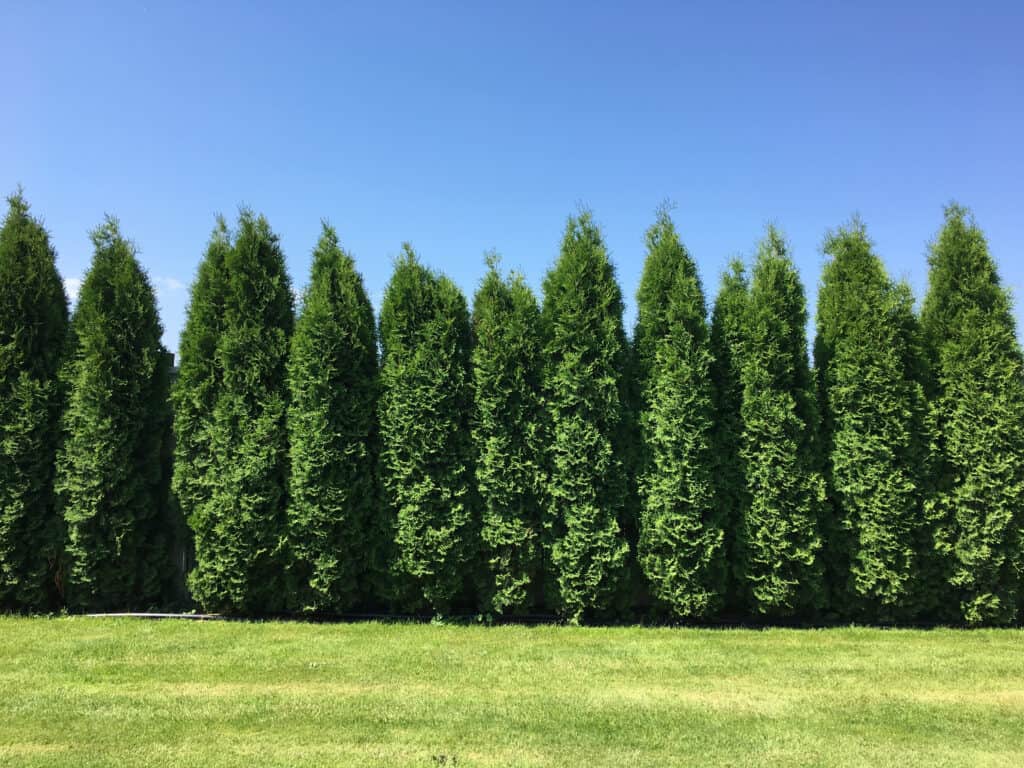
Thuja ‘Green Giant’ is popular because it is adaptable to many soils, requires almost no pruning, and is not susceptible to many pests or diseases.
©soon dug joo/Shutterstock.com
Leyland Cypress vs. Thuja ‘Green Giant’: Uses
While Leyland cypress and Thuja green giants are both used in creating a hedge or privacy screen, their unique qualities make them suitable for slightly different purposes and environments.
Leyland Cypress Uses
Though Leyland cypress trees have long enjoyed popularity when growing hedges for privacy or to reduce noise, they have fallen out of favor with many home landscapers. Unfortunately, Leyland cypress is susceptible to many different pests and diseases. Some of these issues are not possible or easy to resolve. In particular, Coryneum canker is a major threat to conifers, including Leyland cypress. “Canker” is a slow-spreading fungus. It damages trees and disrupts their natural growth. If you identify canker on a branch of your tree, it is important to remove that limb immediately.
Because of these threats, many experts suggest choosing an alternative tree – such as the Thuja ‘Green Giant’ – which will not have the same problems. Additionally, their tall heights combined with their tendency toward weak root systems and susceptibility to root rot can cause them to fall. This makes them a bad option for places with strong winds.
Leyland cypress trees also have created concern about toxicity to farm animals who have grazed the Leyland cypress, so experts advise against planting this tree near horses, goats, and pets that like to chew on branches.
Thuja ‘Green Giant’ Uses
Because they are resistant to pests and do not require much pruning, Thuja green giants are an easy-to-care-for option for creating a hedge. Particularly in comparison to the pruning required for the Leyland cypress and its increasing susceptibility to pests, Thuja green giants are an easier alternative. For this reason, Thuja green giants are a popular choice for growing close together to reduce noise from a highway or busy neighborhood, provide privacy, or break the wind. It is recommended to plant green giants in groups of three, interspersed with other similar trees. This will help to protect your hedge in the event of a disease, by not cultivating a monoculture that will be vulnerable to the same threats.
In Summary
This article compares two coniferous evergreen trees frequently used in North American landscaping, particularly when creating a hedge. Both of these trees have similar uses. Both are fast-growing options for creating a privacy screen or natural hedge to block noise or the wind. While Thuja green giants arrived on the market more recently, they are growing in popularity as a good alternative to the long-time favorite, Leyland cypress. As discussed in this article, they are gaining prominence for several reasons.
- Over time, Leyland cypress trees have become susceptible to insect pests and disease. This has caused some experts to warn against planting them. In comparison, Thuja green giants are resistant to pests and disease and do not have many major threats.
- Leyland cypress trees should be pruned regularly, but Thuja green giants require very little upkeep and pruning.
- Leyland cypress trees are vulnerable to strong winds and cold temperatures. They typically do not grow well in USDA Hardiness Zone 5. However, Thuja green giants do a good job of shielding from the wind and can grow in USDA Hardiness Zone 5.
For these reasons, you may want to consider planting a Thuja ‘Green Giant’ when seeking to create a hedge. While both trees are fast-growing options with year-round foliage, this article shares some main considerations that could inform which you choose to grow.
Does Leyland Cypress Make A Good Christmas Tree?
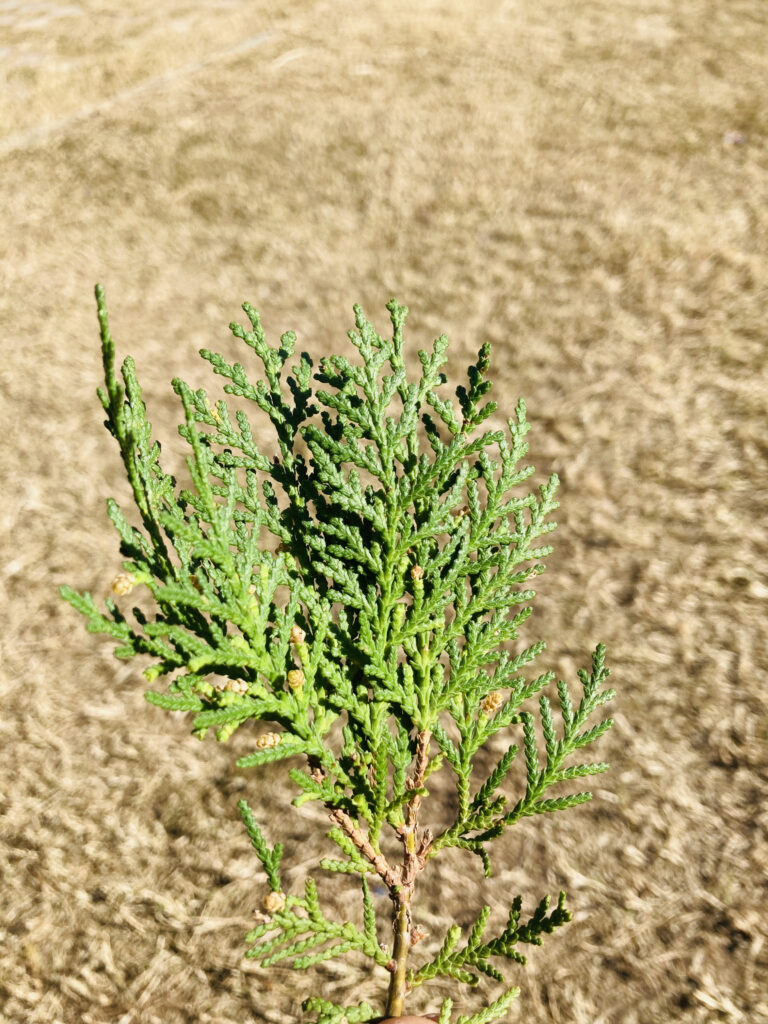
Leyland cypress make beautiful Christmas trees due to their festive color.
©iStock.com/KK1HB
When picking out the type of tree to bring into your home for Christmastime, there are many factors to consider, such as size, color, scent, pine needles, and allergies. An excellent choice if you live in the southeast of the United States is the Leyland cypress. First of all, the color ranges from a deep green, grayish hue to a medium green, which is optimum for the season. Second of all, since the Leyland cypress isn’t in the pine or fir family, it doesn’t produce sap. The lack of sap and strong aroma make it the perfect choice for people with allergies. Third of all, there is minimal mess since these trees do not shed pine needles. One downside of the Leyland cypress as a Christmas tree is that the leaves bend easily, so heavy ornaments will lack support unless attached deep into the tree.
The photo featured at the top of this post is ©
Sources
- Yale University, Available here: https://naturewalk.yale.edu/trees/cupressaceae/cupresus-x-leylandii/leyland-cypress-71#:~:text=Origin%2C%20history%2C%20and%20uses%3A,fertilized%20by%20the%20Monterey%20cypress.
- CAES Newswire, Available here: https://newswire.caes.uga.edu/story/4006/leland-cypress.html
- USDA, Available here: https://www.usna.usda.gov/assets/images/as_standard_image/Thuja_Green_Giant.pdf
- University of Arkansas Extension, Available here: https://www.uaex.uada.edu/yard-garden/resource-library/plant-week/green-giant-arborvitae-1-27-06.aspx
- North Carolina Extension, Available here: https://plants.ces.ncsu.edu/plants/thuja-green-giant/
- The Spruce, Available here: https://www.thespruce.com/leyland-cypress-trees-2132063
- Arbor Day Foundation, Available here: https://www.arborday.org/trees/treeguide/treedetail.cfm?itemID=828
Thank you for reading! Have some feedback for us? Contact the AZ Animals editorial team.






